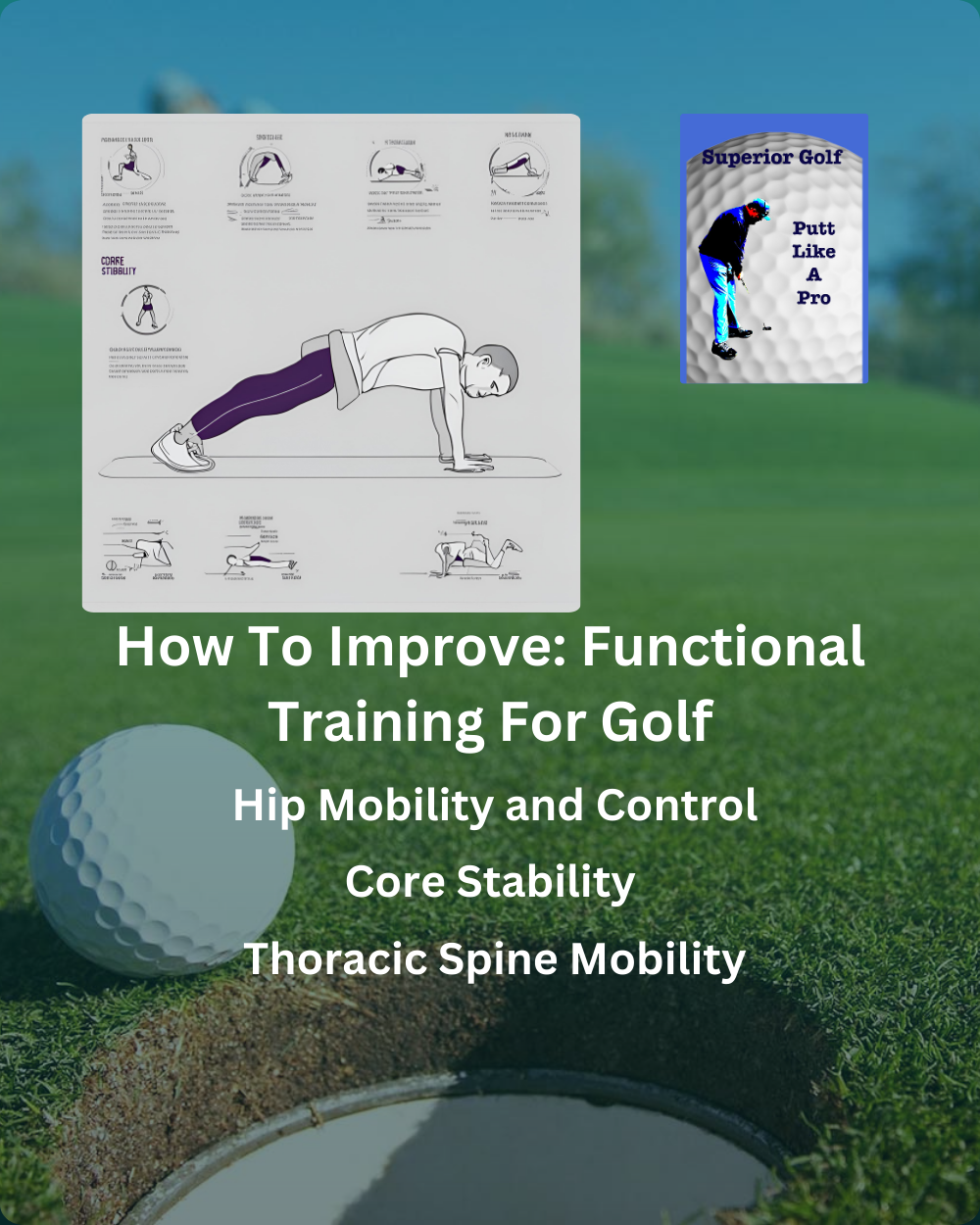Functional Training For Golf: Picture yourself on the tee box, with the sun on your shoulders. Your mind is clear, focused on your next swing. You’ve worked hard on your technique, but something isn’t right. Maybe it’s stiff hips or a lack of control.
Golfers everywhere, pro or amateur, face this. They look for ways to get better and enjoy the game more. Traditional training has changed, making room for functional training. It focuses on mobility, control, strength, and speed—all vital for a great swing. Hip mobility is key but often missed. Poor hip rotation can lead to back pain for golfers1. So, exercises are added to help with movement and control.
Improving your golf fitness isn’t just about avoiding injury. It’s about playing better. Special programs offer over 50 programs, 100 workouts, and 3000 exercises. With these, you get ready both physically and mentally1. These programs help everyone, no matter their fitness level. They ensure your training helps your game grow.
The prehab program gets you ready for golf, both in body and mind. It stresses the need for a balanced workout. This includes flexibility, strength, and control1. Adding functional training to your routine does more than improve your swing. It enhances your overall health, letting you enjoy playing more confidently and precisely.
Key Takeaways
- Functional training is essential for improving golf fitness and enhancing overall performance.
- Traditional golf training has evolved to include mobility, control, strength, and speed exercises.
- Reduced internal rotation of the lead hip is a high predictor of low back pain in golfers1.
- Programs provide access to over 50 programs, 100 unique workouts, and 3000 exercises1.
- Investing in golf fitness helps prevent injuries and promotes mental and physical readiness1.
Understanding the Importance of Functional Training in Golf
Functional training is key to golf today. It matches how we move in three directions and the modern golf swing.2 *Effective golf swings use all muscle, ligaments, and joints*. It all starts with the lower body, mainly the hips, for the best swing power.
The hip’s turning ability greatly affects golf skills. *Functional training for golf stresses strengthening the core for better stability, speed, flexibility, and power*2. This is crucial for avoiding golf injuries since biomechanics greatly improve golf play.
Having a mobile thoracic spine and a stable core is essential for a good golf swing. It also prevents repetitive strain injuries. Research points out that *golf often leads to lower back issues*, making it important to keep the lumbar area stable to avoid getting hurt2. Reports say that *60% of professional golfers and 40% of amateur golfers get injuries that keep them from playing*. This shows how important the right training is3.
Dynamic workouts made for golfers aim to boost mobility and strength. They target specific muscles important for golf. *Functional training zeroes in on customized exercises for golf to better swing skills*2. This helps golfers use their body correctly and hit their peak performance.
*With correct training, you could lower golf injury risks by 50%*, pointing out how vital a well-planned training routine is for golfers at any level3. The activity of trunk muscles is also a big part of playing well in golf, and several studies point to how crucial lumbar stability is to avoid injuries4.
Embracing a full-on approach to functional training can really level up a golfer’s swing, prevent injuries, and boost their overall game. By practicing exercises that aim at core stability, hip movement, and spine flexibility, golfers prep themselves well for the game’s demands.
- *Research shows that the right exercise programs can make club head speed 1.6-7% faster and increase driving lengths by 4-8%*3.
- *Overuse injuries make up to 82% of all golf injuries*, stressing the importance of the right functional training3.
- *How often golfers get injured also depends on their handicap level, higher injury rates are seen with lower handicaps*3.
- *Functional training helps avoid common mistakes like bad posture in golf swings*2.
Key Exercises for Functional Training for Golf
For golfers, focusing on hip mobility, core stability, and spine mobility is essential. Each area boosts golf performance, leading to better swings and fewer injuries.
Hip Mobility and Control
Enhancing hip flexibility can significantly improve your swing. The 90-90 hip stretch is great for internal and external rotation needed in swings1. Kettlebell exercises, like hand-offs, improve hip control and stability. This is key for a powerful downswing and rotational force1.
Core Stability
Core stability helps transfer swing power efficiently. The bird dog exercise with bands boosts core activation for golfers. It builds a strong base, prevents injuries, and supports a mechanics-driven swing. Keeping your hips flexible and core strong ensures balance and stability, which modern golf training emphasizes5.
Thoracic Spine Mobility
Flexibility in the spine is crucial for a good golf swing. Stiffness in the mid-back can hurt your performance and increase injury risk. Doing exercises aimed at the thoracic spine, like upper back stretches and Spieth’s drill, improves rotation. Such drills enhance mobility for a smoother and more powerful swing, matching physical ability with golf excellence1.
Functional Training Programs for Golf Fitness
A golf fitness routine is vital for better play. Tailored programs focus on mobility, stability, strength, and power. They aim to boost your swing and athletic skills while preventing injuries.
Comprehensive Golf Fitness Programs
Golf strength training and golf mobility programs build both functional strength and muscle. Throughout the year, a golf workout program cycles through different phases. This approach fine-tunes specific fitness aspects like muscle building or power maintenance6.
To improve power, golfers should do high-velocity, explosive exercises6. This mixes strength with speed, elevating your game. Exercises like squats, deadlifts, and wood chops focus on strengthening key muscles for golf6.
Famous golfers stress the importance of strength training6. Power training, with good rest times, boosts training movements’ velocity6. Resting well, with light off-season activities, keeps performance high.
It’s crucial to mix exercises that enhance mobility and stability. For lower body stability, focus on hip mobility and glute strength5. Try pelvic tilts, lateral band walks, and medicine ball throws for hip mobility. Pallof Press and single leg balance exercises help with balance5.
A positive mindset and mindfulness matter in golf fitness. Those aiming for more power and consistency will find success with the right workout plan5.
Conclusion
Including functional training in your golf workouts is key for better play. It’s also vital for success in golf training. Players with lower handicaps usually swing their clubs faster. This shows the need for fitness plans that boost physical skills7. Such training helps golfers at any age or practice rate, showing its value for all skill levels7.
Working on muscle strength and flexibility can really improve your golf game and cut down on injuries. For example, strong grip strength links to great golf scores, so strength training is crucial7. Keeping your lower back stable through targeted exercises also matters. This is backed by studies of pro golfers4. This full approach not only ups your game but also lets you enjoy golf more, for longer.
Advice from sports science stresses the big impact of tailored training and staying flexible, even in the off-season. For instance, using weights and plyometric exercises can boost your golf drive4. So, a detailed functional training plan is a smart move for your golfing future. It prepares you to play well and stay safe. snooper>
Learn more about electromyographic analysesExplore muscular coordination for spinal stability
FAQ
What is functional training for golf?
Why is hip mobility important for golf?
How does functional training help in preventing golf injuries?
What are some core stability exercises for golf?
What is the importance of thoracic spine mobility in golf?
How can functional training improve my golf performance?
What are some key exercises for improving hip mobility in golf?
What is kinematic sequencing, and why is it important in golf?
How can a comprehensive golf fitness program benefit me?
What is the TB12 approach to golf fitness?
Source Links
- https://theprehabguys.com/best-exercises-for-golf/
- https://method-athlete.com/blog/33768/Functional-Training-for-Golf
- https://www.pottsmerc.com/2023/01/11/golf-sports-performance-functional-exercise-training-improves-ball-accuracy-and-flight-distance/
- https://www.ncbi.nlm.nih.gov/pmc/articles/PMC1839980/
- https://tb12sports.com/blogs/tb12/5-functional-exercises-every-golfer-should-be-doing
- https://www.verywellfit.com/weight-training-for-golf-3498749
- https://www.ncbi.nlm.nih.gov/pmc/articles/PMC3737887/

